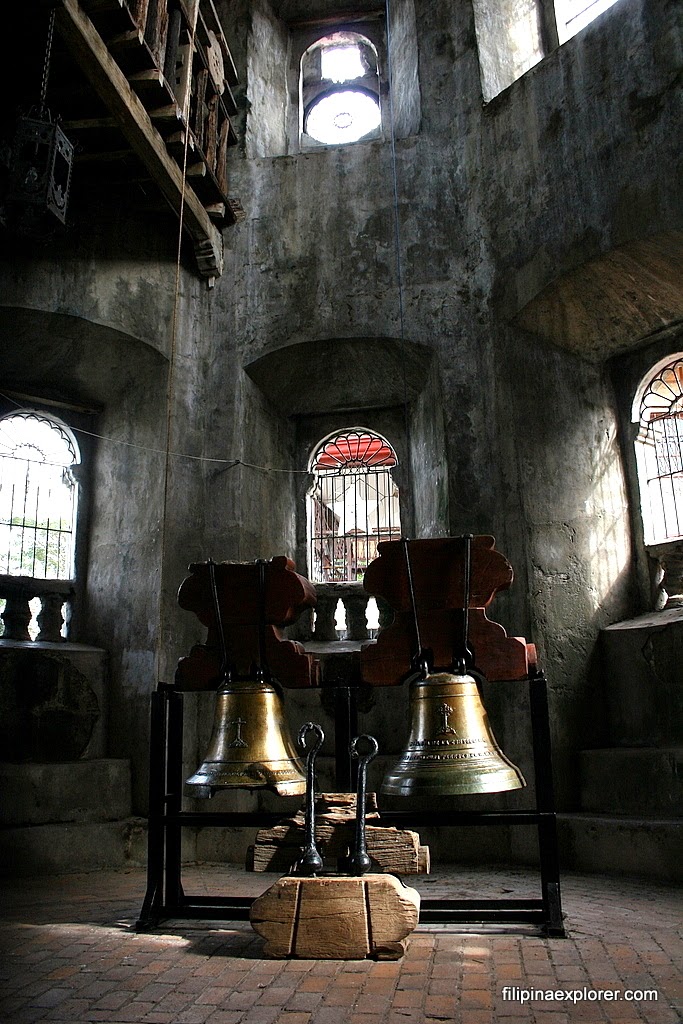The signs, inviting, were
ubiquitous around SM San Fernando’s PUJ terminal. One beckoned to Candaba, one
to Guagua, another to Arayat, others to the farther towns of Pampanga and
Bulacan. I snickered victorious at the scent and sights of hectic Pampanga in
early January, this being the unfolding of one of my longest-standing bucket
list items: to travel solo beyond Bulacan.
ubiquitous around SM San Fernando’s PUJ terminal. One beckoned to Candaba, one
to Guagua, another to Arayat, others to the farther towns of Pampanga and
Bulacan. I snickered victorious at the scent and sights of hectic Pampanga in
early January, this being the unfolding of one of my longest-standing bucket
list items: to travel solo beyond Bulacan.
|
Sunken belfry in San Guillermo Parish. Superbly serene despite the diminished size.
|
Candaba has a wonderful
swamp that I’ve forever longed to see, but it was too late in the morning for
bird spotting. Further, the 30-minute trek to the swamp wasn’t the best
idea to do with a toddler under the tropical heat.
 |
| San Guillermo Parish Interior |
At one corner of SM was a glinting golden
carousel that reminded me of chapels.
carousel that reminded me of chapels.
For hardcore Catholics,
the olden tradition of Visita Iglesia is usually reserved for the Holy Week,
often on Maundy Thursday to seven churches of their choice. But I for one, am
hardly hardcore. Not even by the laziest Catholic standards. In a heartbeat I
take the Betis-bound jeepney and decide to visit two: the famed Sistine Chapel
of the Philippines in Betis and the half-submerged San Guillermo Parish in
Bacolor.
the olden tradition of Visita Iglesia is usually reserved for the Holy Week,
often on Maundy Thursday to seven churches of their choice. But I for one, am
hardly hardcore. Not even by the laziest Catholic standards. In a heartbeat I
take the Betis-bound jeepney and decide to visit two: the famed Sistine Chapel
of the Philippines in Betis and the half-submerged San Guillermo Parish in
Bacolor.
 |
| Hellenic doors of San Guillermo. Fits a 5’5″ person. |
Traveling to these churches despite the heat was superb. The farm-straddled, long-spanning streets and
highways are clean and free of bedlam. Right next to the road, near the Guagua
proper entry, there’s a small and tranquil fish pond flanked by nipa houses
where swarms of egrets nosedive, clear as lens and massive in daylight. It’s
the unchained melody of all melodies.
highways are clean and free of bedlam. Right next to the road, near the Guagua
proper entry, there’s a small and tranquil fish pond flanked by nipa houses
where swarms of egrets nosedive, clear as lens and massive in daylight. It’s
the unchained melody of all melodies.
Bacolor
San Guillermo Parish
The entire church, including the gorgeous stone facade, juts from the cement and the grass, dwarfed yet enigmatic. The exterior is rich, with doors that flaunt Greek architecture.The whole compound is securely built in a silent nook in Bacolor, surrounded by a supersized gate. Visitors come by every 10 minutes, most of them in cars. There’s plenty of parking space to accommodate batches upon batches of such.
 |
| Recuerdo |
San Guillermo is famous for two things: one, as the filming location for the ABS-CBN primetime soap Santino, and two, for being half-buried in lahar after the 1991 Mt. Pinatubo havoc. You’d think the damage would leave it devastated but if anything, it only made it magical.
The entire church, including the gorgeous stone facade, juts from the cement and the grass, dwarfed yet enigmatic. The exterior is rich, with doors that flaunt Greek architecture.The whole compound is securely built in a silent nook in Bacolor, surrounded by a supersized gate. Visitors come by every 10 minutes, most of them in cars. There’s plenty of parking space to accommodate batches upon batches of such.
 |
| Breezy resting area fronting the capacious parking lot. Those tiny windows used to be large doors. |
The grassy backyard near the museum (Museo de Bacolor) and the souvenir shop (yes, it has one!) is most apt for musings, and bears an old wishing well for prayers. It’s green and quiet even on a Sunday.
This easily became my favorite of all the churches I visited that day even if interior-wise, Betis Church is more impressive. It has that distinct – cliche’ ahead – je ne sais quoi that calms and draws, from the faintly lit recuerdos to the pillars down to the moss-covered exterior.
Guagua
San Roque Chapel
On the way to Betis, the
jeepney passes by the weeny yet gorgeous San Roque Chapel at the roadside.
Despite its location, it is surprisingly peaceful. I made my way there on foot,
after a visit to San Guillermo Parish. It’s a mere 10, 15-minute walk from
Guagua Plaza where Immaculate Conception Parish is located.
jeepney passes by the weeny yet gorgeous San Roque Chapel at the roadside.
Despite its location, it is surprisingly peaceful. I made my way there on foot,
after a visit to San Guillermo Parish. It’s a mere 10, 15-minute walk from
Guagua Plaza where Immaculate Conception Parish is located.
Burrowed in the quieter,
homey corner of Guagua Plaza, behind the Herculean Catholic
Center. There’s a pronounced community feel to it, perhaps an influence lent by
location (there’s a basketball court and several homes right in front of the
facade).
homey corner of Guagua Plaza, behind the Herculean Catholic
Center. There’s a pronounced community feel to it, perhaps an influence lent by
location (there’s a basketball court and several homes right in front of the
facade).
It was its reputation as
the local version of the Sistine Chapel and it being a National Cultural Treasure
that transformed Betis Church into a buzzed-over town attraction, open all-day to
visitors (the main entrance upfront is sometimes closed during lunch, but
there’s a path to the left of the main entrance that offers back door
access).
But after the mass baptisms and filled aisles of Sunday masses, Betis Church is abuzz, glorious in all its Michaelangelo-like 18th century ceiling murals – my favorite of which is the one on the Church dome. Adjacent to the Church is the Betis museum, home to important Betis town artifacts.
the local version of the Sistine Chapel and it being a National Cultural Treasure
that transformed Betis Church into a buzzed-over town attraction, open all-day to
visitors (the main entrance upfront is sometimes closed during lunch, but
there’s a path to the left of the main entrance that offers back door
access).
But after the mass baptisms and filled aisles of Sunday masses, Betis Church is abuzz, glorious in all its Michaelangelo-like 18th century ceiling murals – my favorite of which is the one on the Church dome. Adjacent to the Church is the Betis museum, home to important Betis town artifacts.
I end the day at a nearby carinderia where I purchase an assortment of classic Kapampangan dishes for pasalubong, debilitated but happy, with an equally blithe toddler on the hip. It doesn’t take seven churches to awe and inspire faith either from oneself or a higher power. All
it takes is a pair of itchy feet.
it takes is a pair of itchy feet.
 |
| Jaw-dropping murals that can rival Michaelangelo’s. |
How to go to these
churches:
churches:
Make your way to SM San
Fernando and board a jeepney to Betis. The jeepney will pass by San Roque
Chapel on the way to Betis, but not vice versa, so if you want to avoid the
15-minute walk, alight at San Roque Chapel, then board another jeepney going to
Betis Church in front. Jeepneys pass right beside Betis Church. Just tell the
driver to drop you off there.
Fernando and board a jeepney to Betis. The jeepney will pass by San Roque
Chapel on the way to Betis, but not vice versa, so if you want to avoid the
15-minute walk, alight at San Roque Chapel, then board another jeepney going to
Betis Church in front. Jeepneys pass right beside Betis Church. Just tell the
driver to drop you off there.
Also at the side of the
Betis Church street you can find jeepneys bound for Guagua Plaza, where the
Immaculate Concepcion Parish is. It’s really fairly easy and you can’t go wrong
if you ask locals. Truth be told, I only originally planned to go to Betis
Church and San Guillermo Parish, and only figured out the way to the others
while aboard the jeepneys, with the help of the locals.
Betis Church street you can find jeepneys bound for Guagua Plaza, where the
Immaculate Concepcion Parish is. It’s really fairly easy and you can’t go wrong
if you ask locals. Truth be told, I only originally planned to go to Betis
Church and San Guillermo Parish, and only figured out the way to the others
while aboard the jeepneys, with the help of the locals.
San Guillermo Parish is
the farthest and can be reached via a Bacolor-bound jeepney from Guagua Plaza,
from SM San Fernando or from Betis Church.
the farthest and can be reached via a Bacolor-bound jeepney from Guagua Plaza,
from SM San Fernando or from Betis Church.
For convenience, you may want to do the Visita in this fashion:
1. San Roque Chapel
2. San Guillermo Parish
3. Betis Church
4. Immaculate Conception Parish
1. San Roque Chapel
2. San Guillermo Parish
3. Betis Church
4. Immaculate Conception Parish











